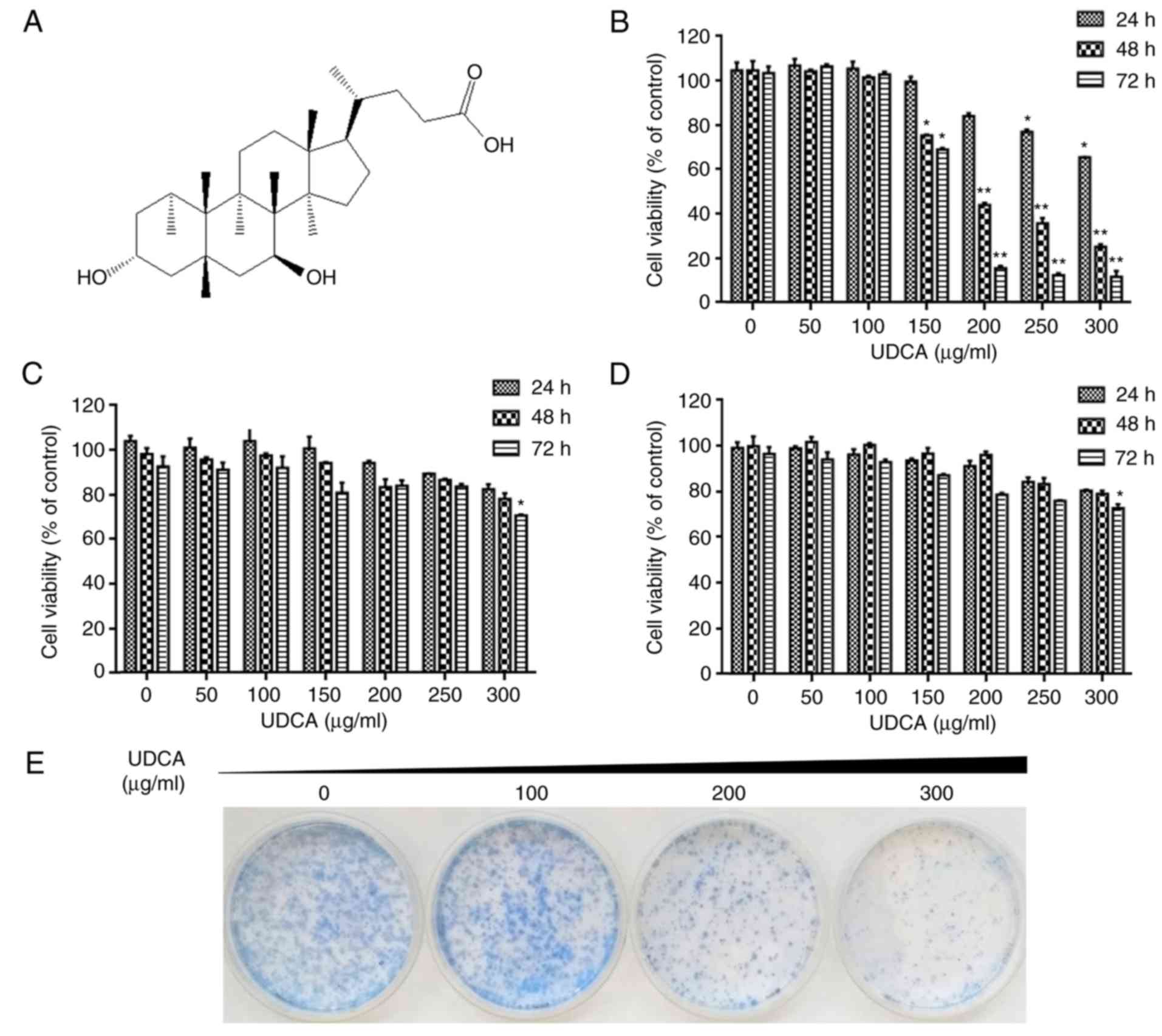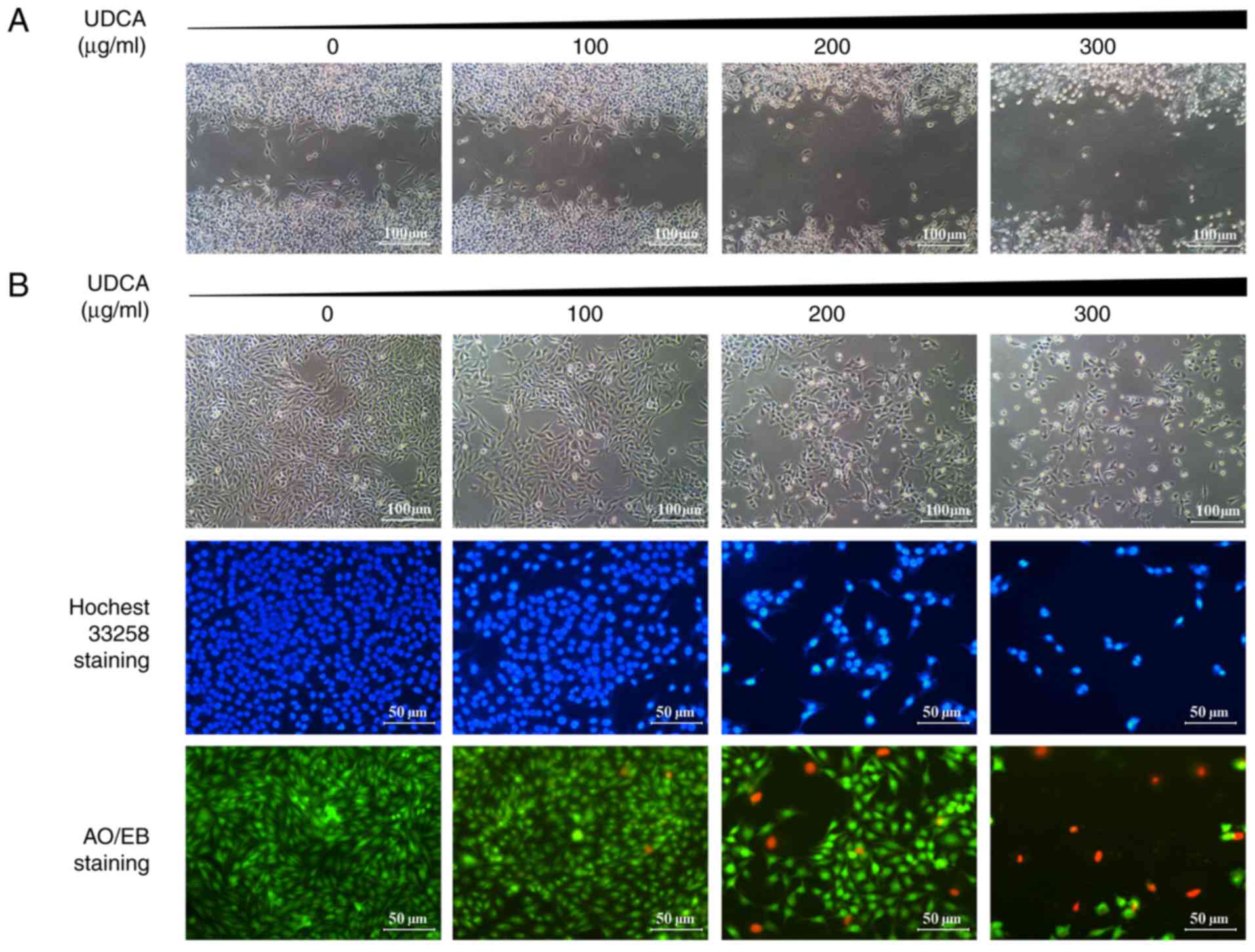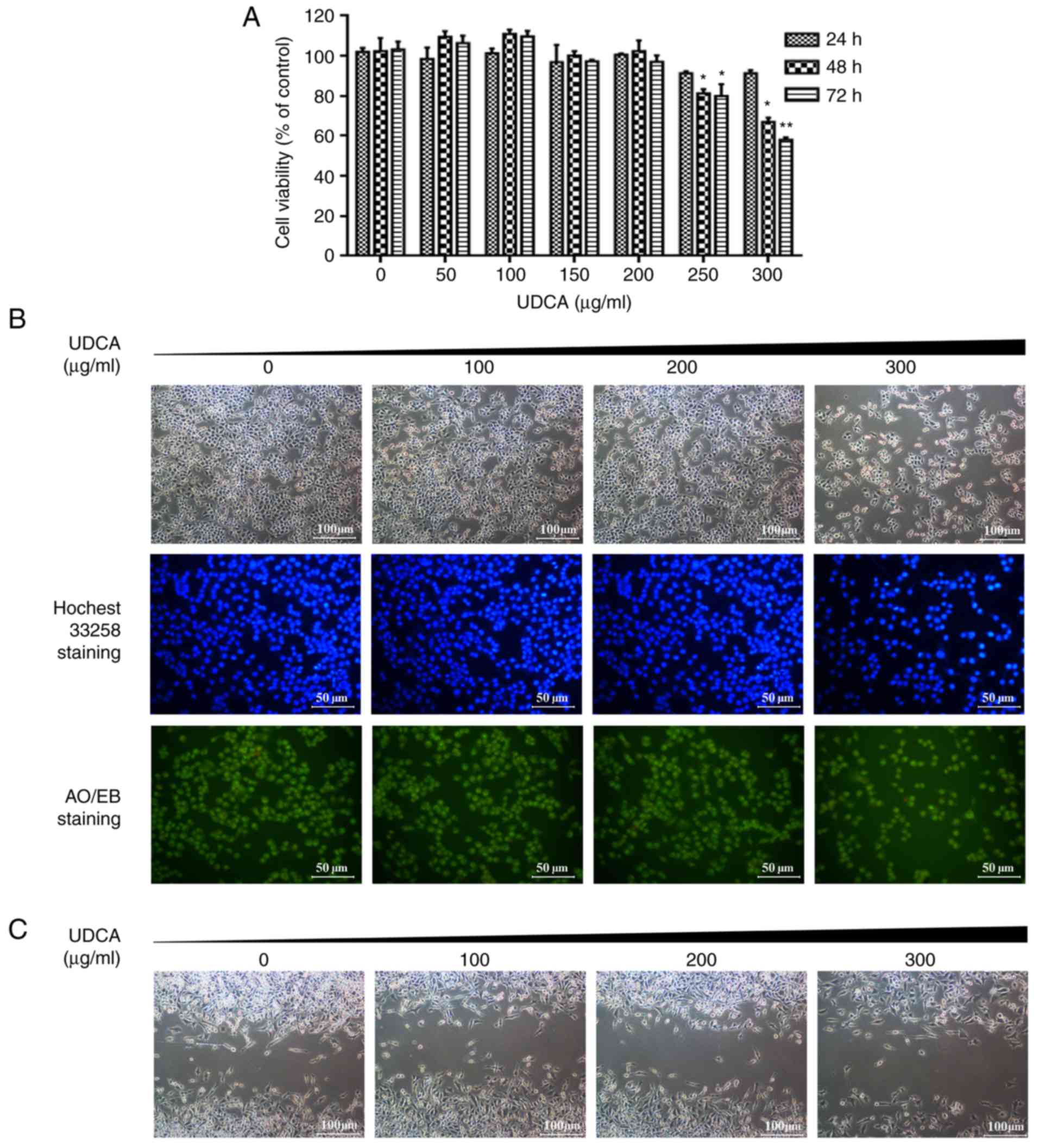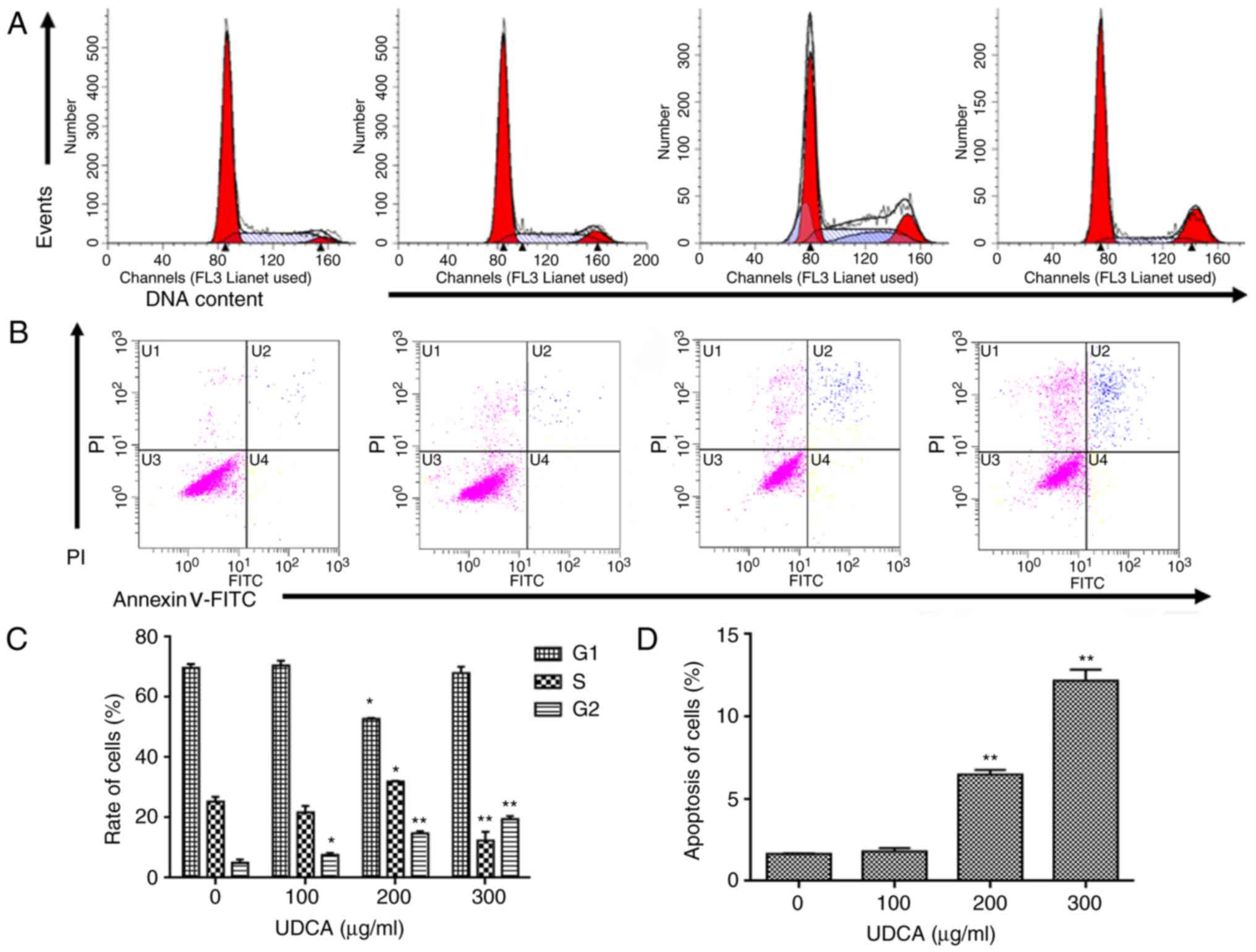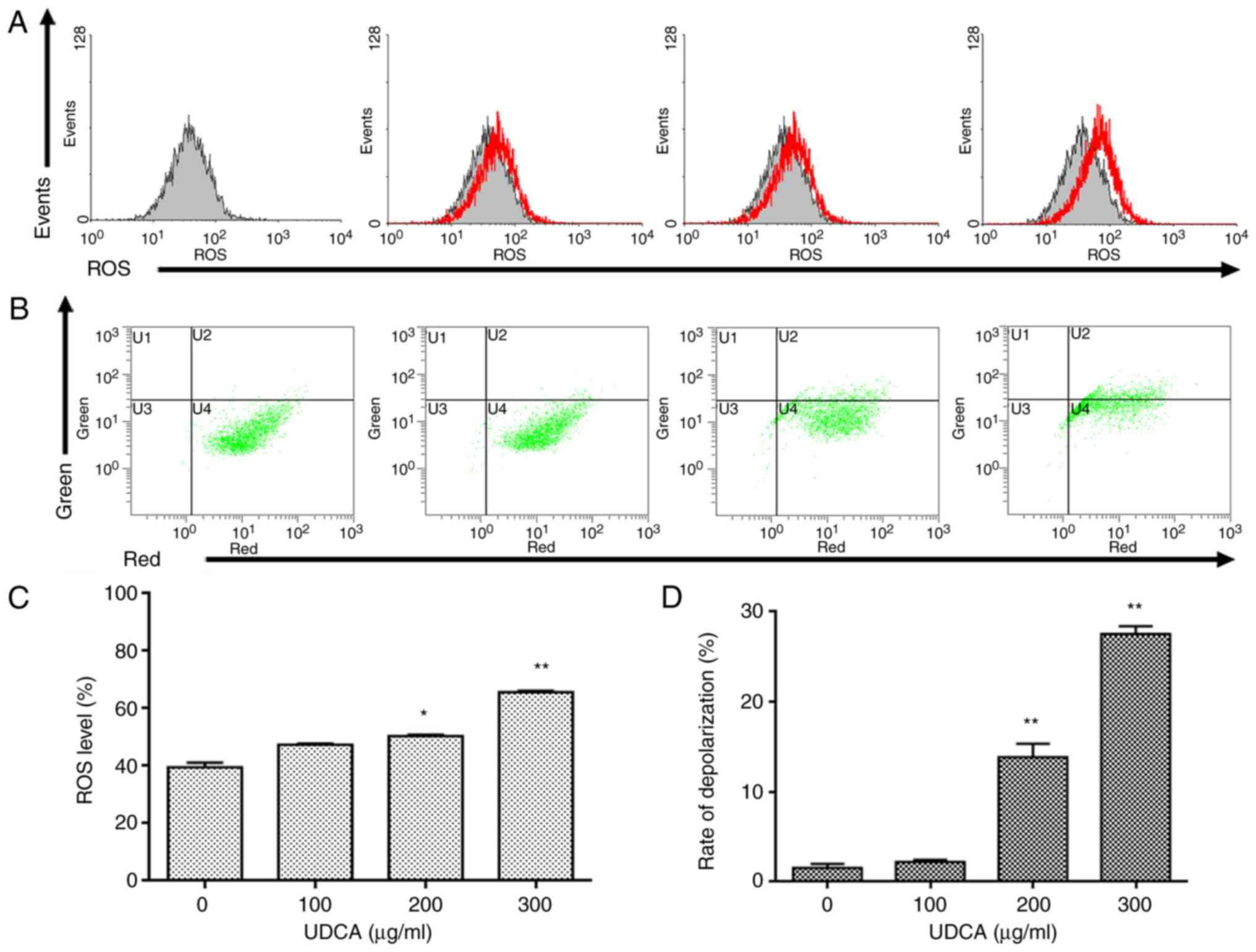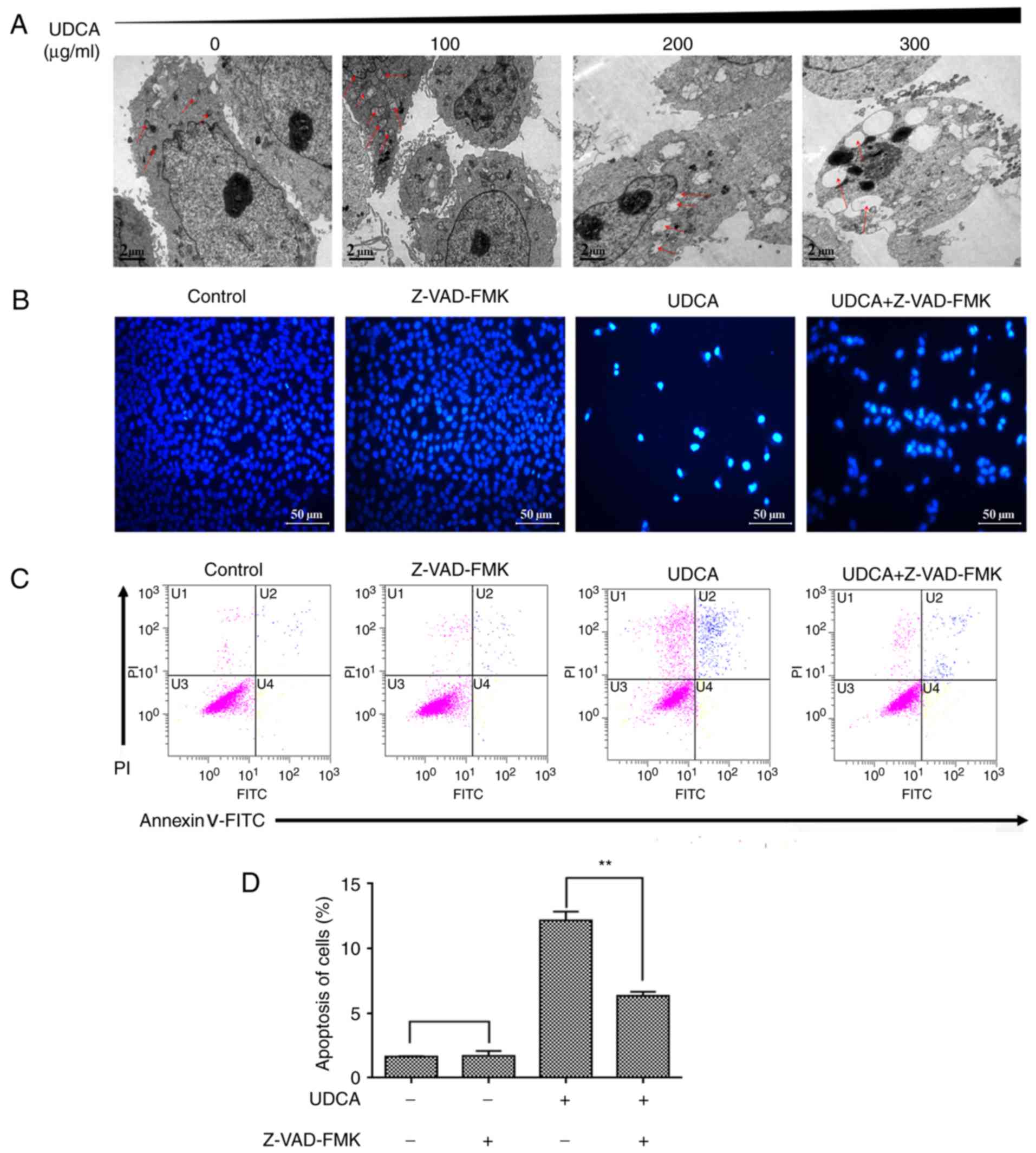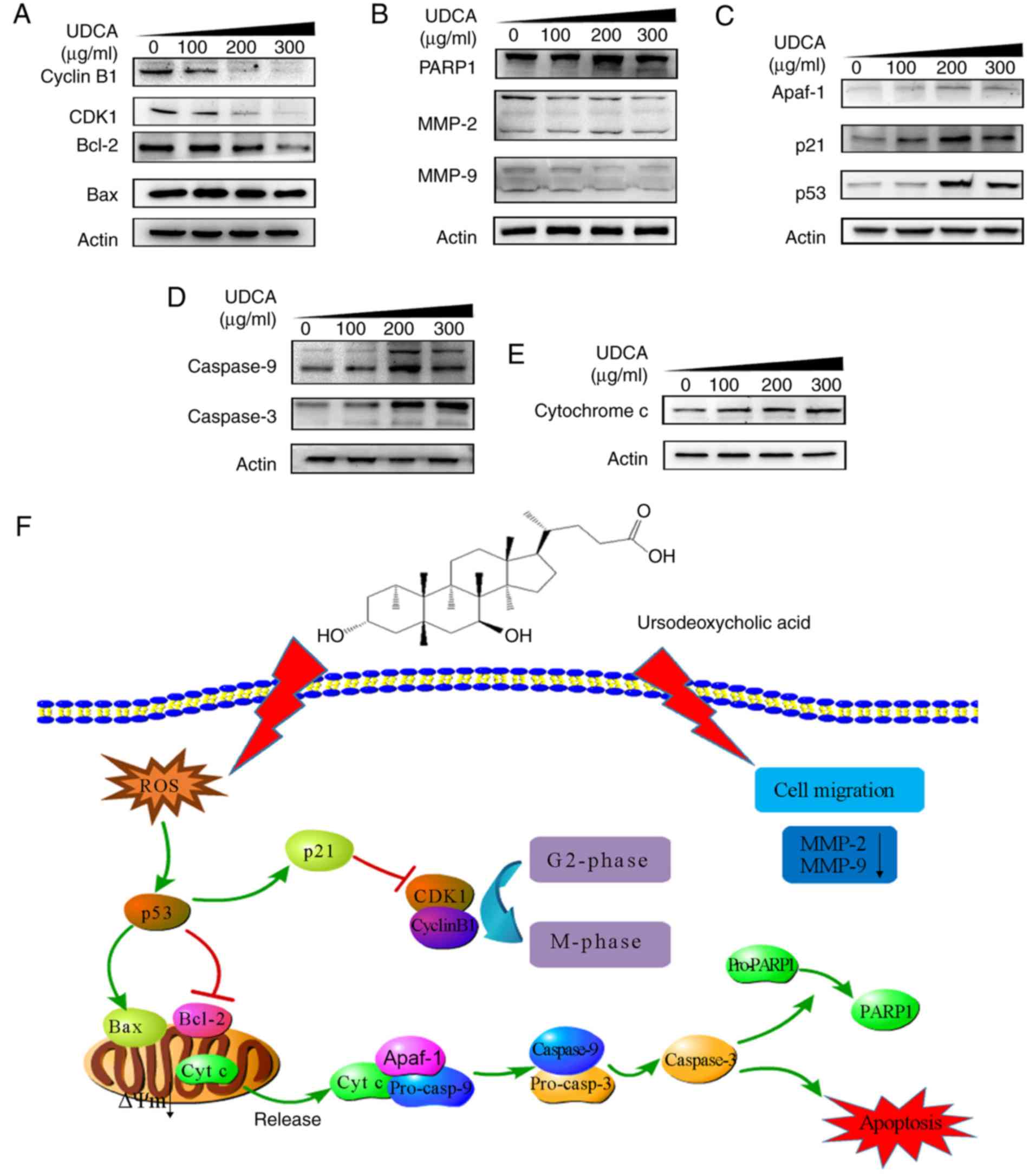|
1
|
Kotb MA: Molecular mechanisms of
ursodeoxycholic acid toxicity & side effects: Ursodeoxycholic
acid freezes regeneration & induces hibernation mode. Int J Mol
Sci. 13:8882–8914. 2012. View Article : Google Scholar : PubMed/NCBI
|
|
2
|
Poupon R, Chazouilleres O, Balkau B and
Poupon RE: Clinical and biochemical expression of the
histopathological lesions of primary biliary cirrhosis. J Hepatol.
30:408–412. 1999. View Article : Google Scholar : PubMed/NCBI
|
|
3
|
Shah SA, Volkov Y, Arfin Q, Abdel-Latif MM
and Kelleher D: Ursodeoxycholic acid inhibits interleukin 1 beta
and deoxycholic acid-induced activation of NF-kappaB and AP-1 in
human colon cancer cells. Int J Cancer. 118:532–539. 2006.
View Article : Google Scholar : PubMed/NCBI
|
|
4
|
Choi YH, Im EO, Suh H, Jin YG, Yoo YH and
Kim ND: Apoptosis and modulation of cell cycle control by synthetic
derivatives of ursodeoxycholic acid and chenodeoxycholic acid in
human prostate cancer cells. Cancer Lett. 199:157–167. 2003.
View Article : Google Scholar : PubMed/NCBI
|
|
5
|
Feldman RA and Martinez JD: S1646 growth
inhibitory effects of ursodeoxycholic acid through negative
regulation of receptor tyrosine kinase activity in human colon
cancer cells. Gastroenterology. 134((4 Suppl 1)): A–241. 2008.
|
|
6
|
Im E and Martinez JD: Ursodeoxycholic acid
(UDCA) can inhibit deoxycholic acid (DCA)-induced apoptosis via
modulation of EGFR/Raf-1/ERK signaling in human colon cancer cells.
J Nutr. 134:483–486. 2004. View Article : Google Scholar : PubMed/NCBI
|
|
7
|
Lim SC and Han SI: Ursodeoxycholic acid
effectively kills drug-resistant gastric cancer cells through
induction of autophagic death. Oncol Rep. 34:1261–1268. 2015.
View Article : Google Scholar : PubMed/NCBI
|
|
8
|
Crowson AN, Magro CM and Mihm MC:
Melanoma. The Melanocytic Proliferations: A Comprehensive Textbook
of Pigmented Lesions. 2nd. John Wiley & Sons, Inc.; Hoboken,
NJ: pp. 254–365. 2014, View Article : Google Scholar
|
|
9
|
Luo C and Shen JY: Research progress in
advanced melanoma. Cancer Lett. 397:120–126. 2017. View Article : Google Scholar : PubMed/NCBI
|
|
10
|
Chisholm JC, Suvada J, Dunkel IJ, Casanova
M, Zhang W, Ritchie N, Choi Y, Park J, Das Thakur M, Simko S, et
al: BRIM-P: A phase I, open-label, multicenter, dose-escalation
study of vemurafenib in pediatric patients with surgically
incurable, BRAF mutation-positive melanoma. Pediatr Blood Cancer.
65:e269472018. View Article : Google Scholar : PubMed/NCBI
|
|
11
|
Dalvin LA, Shields CL, Orloff M, Sato T
and Shields JA: Checkpoint Inhibitor Immune Therapy Systemic
indications and ophthalmic side effects. Retina. 38:1063–1078.
2018. View Article : Google Scholar : PubMed/NCBI
|
|
12
|
Hantel A, Gabster B, Cheng JX, Golomb H
and Gajewski TF: Severe hemophagocytic lymphohistiocytosis in a
melanoma patient treated with ipilimumab plus nivolumab. J
Immunother Cancer. 6:732018. View Article : Google Scholar : PubMed/NCBI
|
|
13
|
Agarwal A, Kasinathan A, Ganesan R,
Balasubramanian A, Bhaskaran J, Suresh S, Srinivasan R, Aravind KB
and Sivalingam N: Curcumin induces apoptosis and cell cycle arrest
via the activation of reactive oxygen species-independent
mitochondrial apoptotic pathway in Smad4 and p53 mutated colon
adenocarcinoma HT29 cells. Nutr Res. 51:67–81. 2018. View Article : Google Scholar : PubMed/NCBI
|
|
14
|
Hegde M, Vartak SV, Kavitha CV, Ananda H,
Prasanna DS, Gopalakrishnan V, Choudhary B, Rangappa KS and
Raghavan SC: A benzothiazole derivative (5g) induces DNA damage and
potent G2/M arrest in cancer cells. Sci Rep. 7:25332017. View Article : Google Scholar : PubMed/NCBI
|
|
15
|
Bi YL, Min M, Shen W and Liu Y: Genistein
induced anticancer effects on pancreatic cancer cell lines involves
mitochondrial apoptosis, G0/G1cell cycle
arrest and regulation of STAT3 signalling pathway. Phytomedicine.
39:10–16. 2018. View Article : Google Scholar : PubMed/NCBI
|
|
16
|
Checchetto V and Szabo I: Novel channels
of the outer membrane of mitochondria: Recent discoveries change
our view. Bioessays. 40:e17002322018. View Article : Google Scholar : PubMed/NCBI
|
|
17
|
Mao XM, Fu QR, Li HL, Zheng YH, Chen SM,
Hu XY, Chen QX and Chen QH: Crocodile choline from Crocodylus
siamensis induces apoptosis of human gastric cancer. Tumor Biol.
39:10104283176943202017.doi: 10.1177/1010428317694320. View Article : Google Scholar
|
|
18
|
Fu QR, Song W, Deng YT, Li HL, Mao XM, Lin
CL, Zheng YH, Chen SM, Chen QH and Chen QX: ESC-3 induces apoptosis
of human ovarian carcinomas through Wnt/β-catenin and Notch
signaling in vitro and in vivo. Int J Oncol.
50:241–251. 2017. View Article : Google Scholar : PubMed/NCBI
|
|
19
|
Su WC, Lin YF, Yu XP, Wang YX, Lin XD, Su
QZ, Shen DY and Chen QX: Mitochondria-associated apoptosis in human
melanoma cells induced by cardanol monoene from cashew nut shell
liquid. J Agric Food Chem. 65:5620–5631. 2017. View Article : Google Scholar : PubMed/NCBI
|
|
20
|
Jimenez-Sánchez A: Chromosome replication
status and DNA content at any cell age in a bacterial cell cycle. J
Theor Biol. 380:585–589. 2015. View Article : Google Scholar : PubMed/NCBI
|
|
21
|
Sundqvist M, Christenson K, Björnsdottir
H, Osla V, Karlsson A, Dahlgren C, Speert DP, Fasth A, Brown KL and
Bylund J: Elevated mitochondrial reactive oxygen species and
cellular redox imbalance in human NADPH-oxidase-deficient
phagocytes. Front Immunol. 8:18282017. View Article : Google Scholar : PubMed/NCBI
|
|
22
|
Kim SY, Kim EK, Jeong AR, Kim YJ, Kim EJ,
Cho JH, Park DK, Kwon KA, Chung JW and Kim KO: Tu1829 The effects
of ursodeoxycholic acid on cell cycle, reactive oxygen species, and
proliferation of colon cancer cell. Gastroenterology. 150((4 Suppl
1)): S9552016. View Article : Google Scholar
|
|
23
|
Seol J, Chaudhari A, Kang H, Kim N, Kim I
and Park S: Gemcitabine sensitizes A549 cells to tumor necrosis
factor-related apoptosis-inducing ligand by up-regulating DR-5
protein and lowering mitochondrial transmembrane potential.
Differentiation. 74:468. 2006.
|
|
24
|
Choi JS, Shin S, Jin YH, Yim H, Koo KT,
Chun KH, Oh YT, Lee WH and Lee SK: Cyclin-dependent protein kinase
2 activity is required for mitochondrial translocation of Bax and
disruption of mitochondrial transmembrane potential during
etoposide-induced apoptosis. Apoptosis. 12:1229–1241. 2007.
View Article : Google Scholar : PubMed/NCBI
|
|
25
|
Yokosuka T, Goto H, Fujii H, Naruto T,
Takeuchi M, Tanoshima R, Kato H, Yanagimachi M, Kajiwara R and
Yokota S: Flow cytometric chemosensitivity assay using JC-1, a
sensor of mitochondrial transmembrane potential, in acute leukemia.
Cancer Chemother Pharmacol. 72:1335–1342. 2013. View Article : Google Scholar : PubMed/NCBI
|
|
26
|
Simeonova E, Garstka M, Koziol-Lipinska J
and Mostowska A: Monitoring the mitochondrial transmembrane
potential with the JC-1 fluorochrome in programmed cell death
during mesophyll leaf senescence. Protoplasma. 223:143–153. 2004.
View Article : Google Scholar : PubMed/NCBI
|
|
27
|
He Y, Zhong GQ, Zeng ZY, Li JY, Li W, Li
WK and Ke HH: Effect of heptanol on apoptosis and structural
changes of mitochondria in ischemia-reperfusion injury of rabbit.
Circulation. 122:E1962010.
|
|
28
|
Goel A and Kim WR: Natural history of
primary biliary cholangitis in the ursodeoxycholic acid era role of
scoring systems. Clin Liver Dis. 22:563–578. 2018. View Article : Google Scholar : PubMed/NCBI
|
|
29
|
Poupon RE, Bonnand AM, Chretien Y and
Poupon R: Ten-year survival in ursodeoxycholic acid-treated
patients with primary biliary cirrhosis. Hepatology. 29:1668–1671.
1999. View Article : Google Scholar : PubMed/NCBI
|
|
30
|
Perez-Holanda S, Rodrigo L, Viñas Salas J
and Piñol Felis C: Effect of ursodeoxycholic acid in an
experimental colon cancer model. Rev Esp Enferm Dig. 99:491–496.
2007.(In Spanish). View Article : Google Scholar : PubMed/NCBI
|
|
31
|
Lim S and Han S: Ursodeoxycholic acid
induces apoptotic death through activation of ERK1/2 and A-SMase in
gastric cancer cells. Virchows Arch. 455:3972009.PubMed/NCBI
|
|
32
|
Kim EK, Kim EJ, Cho JH, Park DK, Kwon KA,
Chung JW, Kim KO and Kim YJ: The effects of ursodeoxycholic acid on
cell cycle, reactive oxygen species, and proliferation of colon
cancer cell. Digestion. 95:982017.
|
|
33
|
Becker S, Schilling L, Krecke N, Thurner
L, Vogt T and Pföhler C: Autoimmune hemolytic anemia as a rare side
effect of pembrolizumab therapy. J Der Deutschen Dermatologischen
Gesellschaft. 16:56–57. 2018.
|
|
34
|
Dambach DM, Andrews BA and Moulin F: New
technologies and screening strategies for hepatotoxicity: Use of in
vitro models. Toxicol Pathol. 33:17–26. 2005. View Article : Google Scholar : PubMed/NCBI
|
|
35
|
Gomez-Lechon MJ, Castell JV and Donato MT:
Hepatocytes-the choice to investigate drug metabolism and toxicity
in man: In vitro variability as a reflection of in vivo. Chem Biol
Interact. 168:30–50. 2007. View Article : Google Scholar : PubMed/NCBI
|
|
36
|
Burcham PC: Target-organ toxicity: Liver
and kidney. In: An Introduction to Toxicology. Springer; London:
pp. 151–187. 2014
|
|
37
|
Amin M, Razi M, Sarrafzadeh-Rezaei F,
Shalizar Jalali A and Najafi G: Berberine inhibits experimental
varicocele-induced cell cycle arrest via regulating cyclin D1, cdk4
andp21 proteins expression in rat testicles. Andrologia. Feb
14–2018.(Epub ahead of print). View Article : Google Scholar
|
|
38
|
Yadav PK, Tiwari M, Gupta A, Sharma A,
Prasad S, Pandey AN and Chaube SK: Germ cell depletion from
mammalian ovary: Possible involvement of apoptosis and autophagy. J
Biomed Sci. 25:362018. View Article : Google Scholar : PubMed/NCBI
|
|
39
|
Marjaneh RM, Hassanian SM, Ghobadi N,
Ferns GA, Karimi A, Jazayeri MH, Nasiri M, Avan A and Khazaei M:
Targeting the death receptor signaling pathway as a potential
therapeutic target in the treatment of colorectal cancer. J Cell
Physiol. 233:6538–6549. 2018. View Article : Google Scholar : PubMed/NCBI
|
|
40
|
Alaimo A, Gorojod RM and Kotler ML: The
extrinsic and intrinsic apoptotic pathways are involved in
manganese toxicity in rat astrocytoma C6 cells. Neurochem Int.
59:297–308. 2011. View Article : Google Scholar : PubMed/NCBI
|
|
41
|
Fernandez-Cardenas LP, Villanueva-Chimal
E, Salinas LS, Jose-Nunez C, Tuena de Gómez Puyou M and Navarro RE:
Caenorhabditis elegans ATPase inhibitor factor 1 (IF1) MAI-2
preserves the mitochondrial membrane potential (Δψm) and is
important to induce germ cell apoptosis. PLoS One. 12:e01819842017.
View Article : Google Scholar : PubMed/NCBI
|
|
42
|
Ali NM, Yeap SK, Abu N, Lim KL, Ky H,
Pauzi AZM, Ho WY, Tan SW, Alan-Ong HK, Zareen S, et al: Synthetic
curcumin derivative DK1 possessed G2/M arrest and induced apoptosis
through accumulation of intracellular ROS in MCF-7 breast cancer
cells. Cancer Cell Int. 17:302017. View Article : Google Scholar : PubMed/NCBI
|
|
43
|
Sardao VA, Oliveira PJ, Holy J, Oliveira
CR and Wallace KB: Doxorubicin-induced mitochondrial dysfunction is
secondary to nuclear p53 activation in H9c2 cardiomyoblasts. Cancer
Chemother Pharmacol. 64:811–827. 2009. View Article : Google Scholar : PubMed/NCBI
|
|
44
|
Barrezueta LF, Oshima CT, Lima FO, De
Oliveira Costa H, Gomes TS, Neto RA and De Franco MF: The intrinsic
apoptotic signaling pathway in gastric adenocarcinomas of Brazilian
patients: Immunoexpression of the Bcl-2 family (Bcl-2, Bcl-x, Bak,
Bax, Bad) determined by tissue microarray analysis. Mol Med Rep.
3:261–267. 2010. View Article : Google Scholar : PubMed/NCBI
|
|
45
|
Dethlefsen MM, Halling JF, Moller HD,
Plomgaard P, Regenberg B, Ringholm S and Pilegaard H: Regulation of
apoptosis and autophagy in mouse and human skeletal muscle with
aging and lifelong exercise training. Exp Gerontol. 111:141–153.
2018. View Article : Google Scholar : PubMed/NCBI
|



